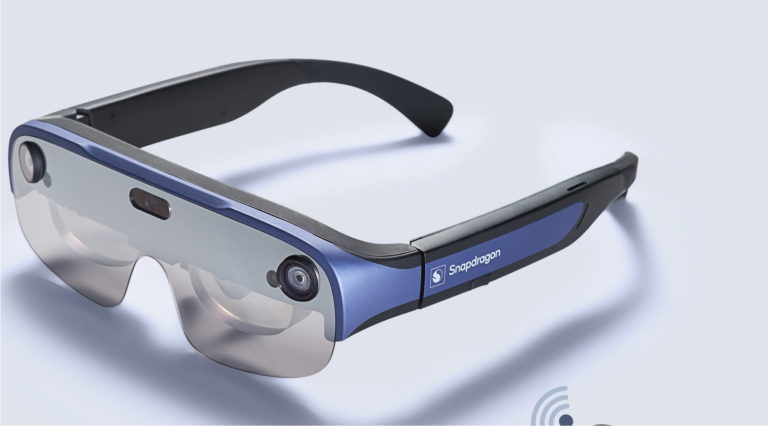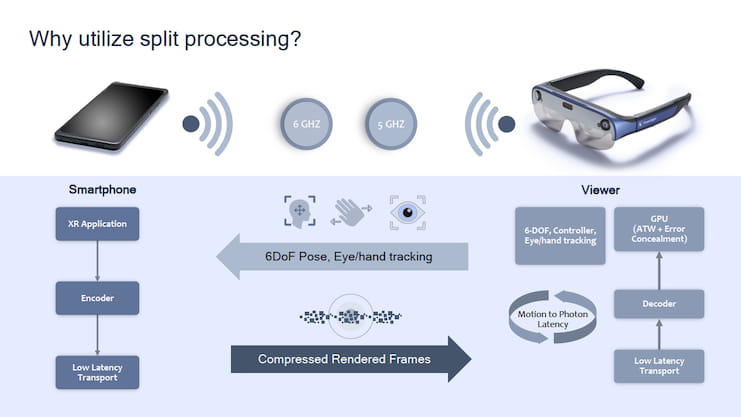
Qualcomm is cutting the cord. The XR-forward chip maker today unveiled a new reference design for smartphone-tethered AR glasses….without the tether. Powered by the Snapdragon XR2 chipset and WiFi 6/6E connectivity, it will provide a north star for OEMs’ next AR evolution.
In that sense, it should be noted that these aren’t glasses that will be shipped to consumers or enterprise end-users. But similarly-looking AR glasses could see the light of day, just as Qualcomm’s XR1-based reference design became a model for Lenovo’s Think Reality A3.
As for the capabilities of the new design, it offers dual 1920 x 1080 micro OLED displays that run at 90 frames per second with a 40-degree diagonal field of view. Three cameras (two monochrome and one color) offer six degrees of freedom movement and hand tracking with gesture recognition.
But the biggest selling point comes down to cutting the cord, representing the next evolution in AR glasses that have a sleeker and unfettered form factor. These are precisely the qualities needed to bring AR glasses to the next level of commercialization for enterprises and consumers.
Split Personality
Stepping back, Qualcomm’s latest design can be better understood by looking at the AR hardware continuum. There are standalone devices like Microsoft Hololens and tethered “viewers” that offload processing and other key functions to a compute host such as a smartphone.
The latter is further subdivided, explained Qualcomm’s XR lead Hugo Swart during a press pre-briefing. They include “simple viewers” like Nreal Light that are basically display peripherals. In this case, most or all of the computing is handled by the nearby corded host.
The second category is “smart viewers” which handle some of these functions on the glasses themselves. Known as split processing, the compute host does the heavy lifting like processing and rendering, while the glasses handle other functions like positional tracking.
This split processing approach has several advantages including power efficiency and a richer UX. And this is what defined Qualcomm’s previous XR1 reference design – the same one mentioned above that became the model for Lenovo’s ThinkReality A3, among other things.
It was also the predecessor for what Qualcomm is announcing today. The XR2 design now has all the benefits of split rendering but without the cord. Data between phone and glasses is transmitted through 5ghz and 6ghz (wifi) connectivity, while apps run on the phone (see graphic below).
Notably, Qualcomm was able to pull off all the above while making the glasses smaller and lighter – to the tune of 40 percent less bulk, says Swart. Meanwhile, there are tradeoffs (as always) for the leap to wireless. These include battery life, though mileage will vary in OEM end-products.

Software and Silicon
Back to connectivity, Qualcomm’s FastConnect 6900 chip and software suite enables the low latency – 3 milliseconds in this case – needed for bandwidth-hungry AR. Here’s where being an increasingly vertically-integrated chip giant comes in handy, tapping into in-house IP.
In that sense, Qualcomm continues to accelerate AR evolution. Its last big move in that sense was its Snapdragon Spaces platform, which brought the company further up the tech stack. The play there had many angles for Qualcomm, including tighter integration of software and silicon.
In fact, that spirit of vertically-integrated feedback loops is also present in Qualcomm’s reference designs… like the one being launched today. Not only are they a “north star” for OEMs as noted, but they help Qualcomm refine the design and evolution of its chips, says Swart.
Meanwhile, the next step in untethered AR viewers has been reached, giving others something to shoot for. In fact, Swart admits this is indeed an evolutionary step and we have several more to go. That leaves plenty of headroom for Qualcomm and others to keep iterating.
“While they’re not yet like my prescription glasses or my sunglasses,” said Swart during the press briefing, “they’re getting to a form factor that you can wear for longer. And without the cable, they are more comfortable for various use cases.”






